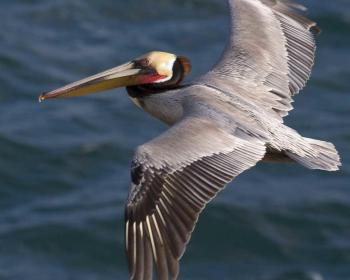Serendip is an independent site partnering with faculty at multiple colleges and universities around the world. Happy exploring!
Levels of Organization in Biology
 This activity uses the example of a flock of pelicans in flight to illustrate how analysis at multiple levels of organization enhances our understanding of a biological phenomenon.
This activity uses the example of a flock of pelicans in flight to illustrate how analysis at multiple levels of organization enhances our understanding of a biological phenomenon.
Through an interactive whole-class discussion of PowerPoint slides, students learn about the multiple levels of organization in biology, as well as reductionism and emergent properties.
To reinforce these concepts, students answer the questions in a Student Handout and discuss their answers in additional whole class discussions.
The first two attached files have the Teacher Notes, including instructional suggestions for the classroom discussions. The PowerPoint is available in the third attached file and as Google slides. The Student Handout is available in the last two attached files and as a Google doc designed for use in distance learning and online instruction. The Teacher Notes explain how this learning activity is aligned with the Next Generation Science Standards (NGSS).
| Attachment | Size |
|---|---|
| levels of organization TN.docx | 1.14 MB |
| levels of organization TN.pdf | 482.4 KB |
| Levels of Biology.pptx | 12.3 MB |
| levels of organization SHO.docx | 3.24 MB |
| levels of organization SHO.pdf | 373.23 KB |











Comments
Problems opening ppt slide show
For some reason I have not been able to open the ppt slide show for Levels of Biology. It appears to be loading for long periods of time without loading.
PowerPoint slideshow
I am able to open the PowerPoint from the link provided. Your problem may be a temporary issue with your network. If you try again and still are unable to open the ppt using the link, are you able to right-click the link and save the ppt file to your computer? And then open the ppt file from there?
I hope that will solve your problem,
Ingrid
Organization of Life
First, let me thank you for organization such a wide variety of activities!! I always like checking in with your site at the beginning of each school year to see what I want to rotate in or out. This is most definitely an invaluable resource!!
Second, I'd like to apologize for bugging you. I need a little bit of guidance on what answer you're looking for to the below problem.
"Fill in the blanks on the right to give examples for a population of frogs living in a pond."
The way I'm reading, is that you want students to give examples of OTHER populations found within the frog's community. But when reading it "give examples for a population of frogs"... what else is in a population other than the frog species?
Thank you for your assistance in this matter and have a wonderful day!
Sincerely,
Amy
Clarification of question
Thank you for your kind words of appreciation.
For the population blank, the correct answer is the population of frogs. For the ecosystem and community levels and for the organism and smaller levels, students should provide appropriate answers. I hope that clarifies the intention of the question sufficiently, but if not, please email me at iwaldron@upenn.edu.
Ingrid
2020 revision
The Teacher Notes have been substantially revised, with expanded instructional suggestions and biology background information. The questions in the Student Handout have been clarified and focused on the key points. The PowerPoint presentation has been streamlined and clarified.
Ingrid
Post new comment